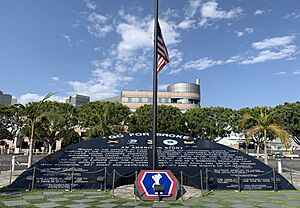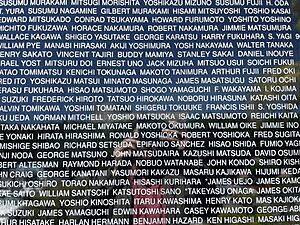Go for Broke Monument facts for kids
The Go for Broke Monument is a special memorial in Little Tokyo, Los Angeles, California. It honors Japanese Americans who bravely served in the United States Army during World War II. The monument's name, "Go for Broke," was a famous motto used by these soldiers.
A talented architect from Los Angeles, Roger M. Yanagita, designed the monument. His design was chosen from many ideas submitted from all over the world. Work on the monument began in 1991. It was officially dedicated on June 5, 1999. You can find it next to the Japanese American National Museum. Anyone can visit the monument for free.
Contents
Remembering Heroes: The Monument
The monument has a large, shiny black stone face that curves. It points towards the sun, and an American flag flies proudly beside it. On the curved back wall, you can read the names of 16,126 soldiers. These soldiers were "Nisei," which means they were Japanese Americans born in the United States.
At the bottom of the flag pole, there's a symbol for the 442nd Regimental Combat Team. This was a famous group made up entirely of Nisei soldiers.
The top of the monument's face shows the motto: "Go For Broke." Below that are the symbols of other important Nisei Army units. These include the 100th Infantry Battalion and the 442nd Regimental Combat Team. Other units like the Military Intelligence Service (MIS) and the 522nd Field Artillery Battalion are also honored.
The 100th Battalion's motto was "Remember Pearl Harbor!" The 442nd RCT used "Go for Broke." This phrase has now become a motto for all Japanese American units from World War II. It means to give everything you have and risk it all to achieve your goal.
The Main Message
The monument's most important part is a large message carved into its face. It tells how these soldiers served their country. They did this even though their own rights were taken away during a difficult time. During World War II, many Japanese Americans were forced to leave their homes. They had to live in special camps, sometimes called "relocation centers" or "concentration camps." The monument uses the term "concentration camps" to show how serious this situation was.
The message on the monument was written by Ben Tamashiro. He was a veteran of the 100th Infantry Battalion. He is also known for appearing in many TV commercials.
You can learn more about the monument at the Japanese American National Museum. There is also a special information stand nearby. Sometimes, veterans who served in these Nisei units visit the monument. They share their stories and answer questions about World War II.
Main Inscription
GO FOR BROKE – An American Story
Rising to the defense of their country, by the thousands they came – these young Japanese American soldiers from Hawaii, the states, America's concentration camps – to fight in Europe and the Pacific during World War II. Looked upon with suspicion, set apart and deprived of their constitutional rights, they nevertheless remained steadfast and served with indomitable spirit and uncommon valor, for theirs was a fight to prove loyalty. This legacy will serve as a sobering reminder that never again shall any group be denied liberty and the rights of citizenship. – Ben H. Tamashiro
Important Words from Leaders
Here are some famous quotes about the Japanese American soldiers:
- "You not only fought the enemy . . . you fought prejudice and won." – President Harry S. Truman said this when he welcomed the 100th/442nd Regimental Combat Team home.
- "Never in military history did an army know as much about the enemy prior to actual engagement" – General Douglas MacArthur, a top commander in the Pacific, said this about the Military Intelligence Service (MIS). The MIS was a group of Nisei soldiers who used their language skills to gather important information.
- "My fellow Americans, we gather here today to right a grave wrong . . . now let me sign H.R. 442." – President Ronald Reagan said this when he signed the Civil Liberties Act of 1988. This law officially apologized for the internment of Japanese Americans during World War II.
- "The Nisei saved countless lives and shortened the war by two years" – Charles A. Willoughby, General MacArthur's Intelligence Officer, said this about the MIS.
See also
- Go for Broke! (1951 film)
- Japanese American service in World War II
- Bainbridge Island Japanese American Exclusion Memorial
- Day of Remembrance (Japanese Americans)
- Densho: The Japanese American Legacy Project
- Empty Chair Memorial
- Fred Korematsu Day
- Harada House
- Japanese American Memorial to Patriotism During World War II
- National Japanese American Veterans Memorial Court
- Nisei VFW Post 8985
- Sakura Square
- Sadao Munemori
- Young-Oak Kim



